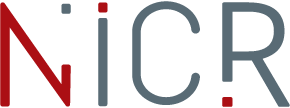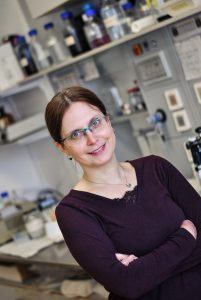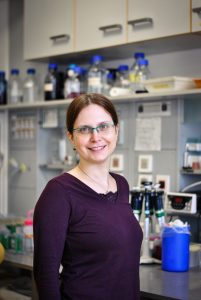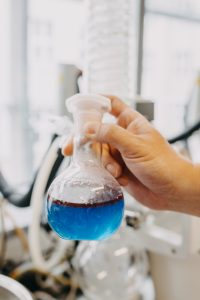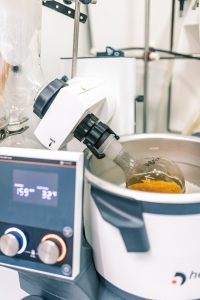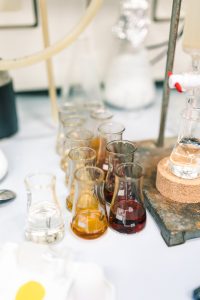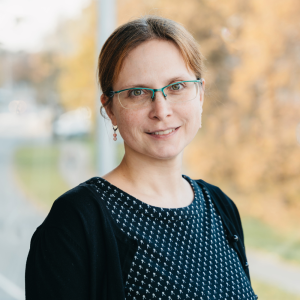
To innovate cancer diagnostics and therapy through the development of targeted small molecules and antibody mimetics, which increase the involvement of the immune system and improve patient outcomes – that is the mission of Jan Konvalinka’s research team ‘Proteases of human pathogens’. The team is based in the Institute of Organic Chemistry and Biochemistry of the CAS and represented in the NICR by Tereza Ormsby. The team has, among other things, developed a highly sensitive method for high-throughput testing of large compound libraries (DIANA) and synthetic antibody mimetics, so-called iBodies, which are created by attaching ligands to biocompatible polymers.
-
In what direction is the research on small synthetic molecules heading today, and what is their potential in cancer diagnostics and treatment?
Answering this question could easily fill an entire lecture, but I will try to highlight just a few key points. The development of small molecules is primarily motivated by efforts to overcome the limitations of current treatments. The goal is to circumvent resistance, develop substances with fewer side effects, and achieve a better therapeutic window. Among the interesting developments in recent years is the so-called PROTAC technology, which can specifically and selectively induce the destruction – literally the “eating” – of proteins involved in a particular disease. Traditionally, the development of small molecules had focused on finding new inhibitors that block the activity of a specific protein. But PROTAC works differently because it essentially erases the protein in question.
Another aim is to develop small molecules that can target and activate the immune system to destroy tumour cells. Also worth mentioning is the development of compounds that regulate the reading, transcription, and realisation of genetic information – in other words, epigenetic mechanisms. Progress has also been achieved in diagnostics, where scientists have developed various targeted radiopharmaceuticals. These are small, radioactively labelled molecules capable of binding to concrete proteins. Some of these are used only for imaging, that is, in diagnostics, but others have therapeutic effects, such as the Pluvicto developed by Martina Benešová from the German DKFZ, which is used to treat prostate cancer.
-
Which area of application of low-molecular-weight ligands does your research team focus on?
We primarily focus on their use in cancer diagnostics and treatment, but we also study their potential in inflammatory and infectious diseases.
-
You have developed a new chemical-biological tool called DIANA. What is its principle, and where will it find its main applications?
DIANA uses a ligand, often an inhibitor, that is bound to an oligonucleotide. The ligand then binds to a specific protein, and using qPCR, we can measure the amount of the bound ligand. This method has two main areas of application. The first is the detection of a specific protein—for instance, determining its levels in blood. The second use is in the screening for new compounds that bind to and block the activity of the protein in question. DIANA is highly sensitive and enables high-throughput screening, making it possible to rapidly test a large number of compounds or samples. We have recently published a study focused on using DIANA for detection and inhibitor screening of the tumour antigen FAP (fibroblast activation protein).
-
The second tool coming from your ‘workshop’ is synthetic antibody mimetics, so-called iBodies, created by attaching ligands to biocompatible polymers. What are their advantages and what possibilities do they offer?
We are developing iBodies in collaboration with colleagues from Tomáš Etrych’s group at the Institute of Macromolecular Chemistry of the CAS. iBodies are HPMA polymers, to which ligands are attached, giving the polymer specific functions. A key component is a small molecule that directs the polymer to specific cells—it essentially gives the polymer a specific ‘address’ by binding to a particular protein on the cell surface. Importantly, a single molecule of the polymer can carry multiple molecules of the ligand, even ten or so. This often results in iBodies with better binding abilities than the small molecule alone. Moreover, the polymer itself is water-soluble, which can improve the solubility of the small molecules.
In addition to the targeting ligand, we can also attach other functional components to the polymer, adding further capabilities. For example, the polymer can carry a fluorescent label, enabling visualisation of labelled cells. We are also testing cytotoxic polymers, which induce cell death. With these, we have been able to eliminate certain leukemic cells. Furthermore, we are using iBodies for target identification in cases where a compound shows a biological effect but its mechanism of action is unknown. We attach this molecule to an iBody that carries an affinity tag for isolation. This polymer is incubated with cells, and if all goes as planned, we can isolate the unknown protein target.
iBodies are thus essentially synthetic substitutes, mimetics, of antibodies. Their advantages include easy preparation, low cost, and high stability. They also allow for precise control over the number of bound ligands, which in turn lets us fine-tune the polymer’s properties. The HPMA polymer is biocompatible, well-tolerated, and does not cause an immune reaction on its own.
-
Small molecules clearly offer great research opportunities. What would you like to focus on next?
We are currently very focused on targeting the FAP protein, which is particularly interesting because it appears on cells that support tumour growth (tumour-associated fibroblasts) but not in the vicinity of healthy cells. We have developed highly effective inhibitors against this protein, and we are now working on turning them into radiopharmaceuticals. Aside from that, in collaboration with Michal Hocek’s team from the Institute of Organic Chemistry and Biochemistry, we are working on inhibitors targeting the CD73 enzyme, which also plays an important role in cancer progression.
-
Is there a more prestigious opportunity for a scientist-chemist in the Czech Republic than working at IOCB?
Our institute is clearly unique within the Czech Republic thanks to its successful history in medicinal chemistry and strong infrastructure. However, there are many prestigious universities and research institutes around the world whose reputation surpasses that of the IOCB. That said, I dare to say we do a lot of things very well and that IOCB offers an inspiring environment for research.
-
Is there an area in your research in which involvement in the NICR consortium is especially beneficial?
Our work crucially depends on collaborations with other institutions that have different facilities and can complement ours – and vice versa. Some of these collaborations we might have pursued even without NICR, but they may not have come to fruition due to a lack of funding. NICR’s support is unique, and it will be hard to replace it if the consortium does not continue. NICR had also helped increase awareness of who does what in Czech oncology research.
-
Your research team is multidisciplinary. What specialisations have gathered under its wings? And how does the ‘chemistry’ within the team work?
Collaboration between chemists (including colleagues from the Institute of Macromolecular Chemistry) who ‘cook’ various compounds and the biochemists who test them, is absolutely critical. We could not function without this cooperation. Among the biochemists we have a wide range of specialisations from structural biologists through enzymologists all the way to immunologists. I think our internal chemistry works well, and we strive to help each other, which is very important.
-
By the way, how did your journey toward chemistry begin? Did you have straight A’s in it in the elementary and secondary school or was there something you were not so good at? :)
Maybe I should start by saying that I don’t really consider myself a chemist—I studied biochemistry at the Faculty of Science at Charles University. Still, my dad was a chemist and my mom a chemical lab technician. All my siblings and their partners studied either medicine or natural science, so I was very much shaped by our family environment. My natural interest in science was always supported—my siblings or dad were ready to explain to me how things worked. I was a good student, although in high school I did not have straight A’s. In chemistry, for example, I once even had a C in the final report. I would say that was my greatest act of teenage rebellion! ☺ Physics was never my thing. Whenever I have to learn something from physics—or when I read answers to physics questions for Ask a Scientist—I feel like my brain goes into total shutdown. I kind of get what’s being said, but I’m just not able to explain it in my own words. I am looking forward to when my son starts physics in school, perhaps I will finally learn it. What really sealed my decision to pursue science was participating in the Students` Professional Activities (SOČ), where I realised that I just really enjoy working in the lab.
-
You are one of the founders of the online project Ask the Scientist. Why? What did you miss in the way science was being communicated to the general public in the Czech Republic? Were there things you considered misleading or outright harmful?
It came out of our dissatisfaction with how public debate was unfolding during the COVID pandemic. Various self-appointed experts were releasing their opinions into the public space, presenting them as absolute truth, although their area of expertise often had nothing to do with the topics they were commenting on. COVID pandemic also revealed that the public does not fully understand how science works and that their expectations did not align with scientific processes. So, it is no surprise that this led to disappointment and frustration when those unrealistic expectations were not met. At the same time, it became evident that there is a real thirst for verified, trustworthy information.
One thing I found – and still find – misleading is how debates about vaccination were handled. The media would place one opponent and one supporter against each other, which gives the impression that support and opposition are evenly balanced within the scientific community. But that simply is not the case. There were also harmful bits of advice being spread such as that one should drink bleach or the debate about ivermectin. My boss, Professor Konvalinka, often says that nonsense kills – and I absolutely agree with that.
-
You have had personal experience working in science in the United States. Are they more advanced in communicating scientific results and science popularisation in general?
To be honest, when I worked in the U.S., I did not pay much attention to that aspect, so I cannot really compare the situation there with the situation here now. But the U.S. is definitely ahead in the sense that there are actual academic programmes focused specifically on science communication. I also remember being surprised that I had to include a lay abstract (one written for general public) in a grant application. I had never had to do that before. It really threw me off and I struggled with it. These days, though, that kind of thing is more common.
-
What could Czech scientists learn from Americans?
Americans are not afraid to aim high, to come up with grand ideas. I think that the absence of formal address in communication helps reduce the sense of hierarchy — bosses do not stand on such high pedestals.
Moreover, in the Czech Republic, there is all this senseless and burdensome administrative work around various grant evaluations, with an unreasonable emphasis on meeting publication quotas, etc.
In general, though, I have a feeling that the situation here is changing for the better. And, unfortunately, the new American administration is now causing such chaos and uncertainty in science that the situation may well reverse.
-
What was the trickiest question you have had to answer as part of the Ask the Scientist project? And where do you look for answers to questions you cannot answer yourself?
Perhaps the most common reason we are unable to answer a particular question is simply the absence of a scientist with relevant expertise and the capacity to write the answer. I am afraid I cannot objectively tell you which question was the trickiest because I am quite biased regarding some topics. I find questions related to physics or very technical topics quite difficult, while biology and related sciences are more my comfort zone.
If there is no existing literature that would help us answer the question, we offer our expert opinion and clearly explain what it is based on. At the same time, we also state explicitly that it is our personal view. There was even one case where we resorted to an experiment. In response to the question “Why do small pasta pieces crawl into larger ones?”, our scientists beautifully demonstrated how scientific inquiry works when there’s no clear answer and no existing literature. So, our colleagues formulated hypotheses and tested them through experiments.
-
Which scientist would you like to ask a question yourself and what would it be?
I think I would be most interested in questions surrounding the origin of life or the beginning of the universe itself. When I was little, these questions really troubled me. Where did I come from? Why is it me who is here? Out of the millions of possibilities, why this particular egg and this particular sperm united to create me? If a different sperm had been faster, it would not be me here but someone else entirely. I was overwhelmed by the sheer randomness of it all. I was also unsettled by the fact that we don’t know where the universe came from or what existed before it.
Of course, I think about it differently today — it’s more about curiosity than fear. If I could really dream big and have the chance to talk with Stephen Hawking, that would be incredible! I probably wouldn’t understand much of what he said, but I’m sure it would be an unforgettable experience.
